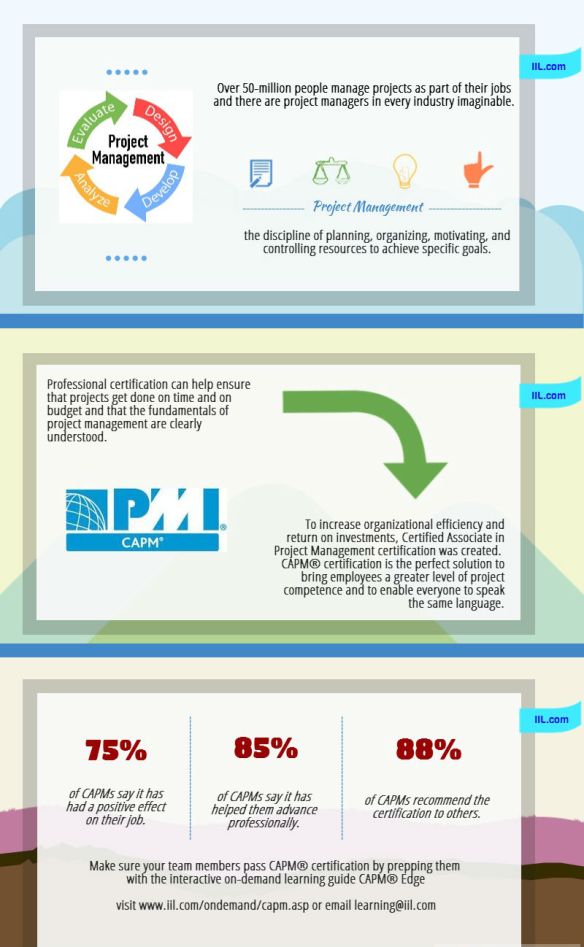CAPM® EDGE is available as a 30-Day-Deal from International Institute for Learning
For more than thirty years, I have travelled the world conducting lectures, seminars and workshops on various aspects of project management. At each location, I am inevitably asked the same question: “What major changes have you seen in your career in project management?” Program participants expect me to talk about the PMBOK® Guide, program management, portfolio management, project management leadership, the PMO, Agile, and other such topics; however, they become quite surprised when I state the biggest change has been in the way we educate project managers.
Today, while most people take project management educational opportunities for granted, it has not always been that way. As a young engineer, I observed the birth of project management in the heavy construction, aerospace and defense industries as well as in NASA’s manned space program. I then decided I wanted my career to be in project management.
I was hired into an aerospace firm desiring to be placed immediately into a project management position with the expectation of attending project management training programs. I was surprised to learn that, not only did my company not have any such educational programs, but there were no such seminars in the marketplace. Instead, employees desiring project management positions often spent the first eighteen months working in various functional disciplines in order to understand how the company functioned and integrated work across a multitude of areas. The argument was simple: project managers cannot integrate work across multiple functional areas without fully understanding how each functional area worked. The emphasis was more on understanding the organization structure than understanding the concepts of Project Management.
After almost two years, I was given the opportunity to go into project management. To this day, I clearly remember my meeting with the Vice President for Engineering when he told me that as a project manager I would be making mistakes. He then went on to say, “The first time you make a mistake, I, the Vice President for Engineering, will take the responsibility for the mistake. If you ever repeat the mistake, you will be fired.” Simply stated, I was expected to learn from my own mistakes rather than from the mistakes of others. What a pity that, as a newly appointed project manager, we did not have any courses similar to the CAPM® Certification, where we could learn from the mistakes of others rather than our own. The only training course my company had related to project management was a course on Earned Value Measurement, which was a necessity for standardized reporting of the status of the project to various government agencies. Needless to say, I did make several, often costly, mistakes and learned from them.
As the need for project managers began to grow, companies became concerned as to how newly appointed project managers would be educated in project management. The primary concern was with the young college graduates who may have had no exposure to project management as of yet. Initially, senior project managers were acting as mentors for the younger would-be project managers. Slowly but surely, seminars appeared in the marketplace on basic project management concepts. These courses were being taught by trainers with years of experience in the aerospace, defense and heavy construction industries, and most of the examples they provided in the training programs came from their own industrial experience, not necessarily applicable to the attendees’ work environment.
At the same time, some universities began teaching project management; however, there was most often just one course taught, and it was listed under engineering—mainly under civil or construction. College degrees in project management were nonexistent. Also, there were no textbooks on the subject.
So, in 1977, I wrote the first edition of my book, Project Management: A Systems Approach to Planning, Scheduling and Controlling. I sent out manuscripts to 30 publishers and received 29 rejection letters. One publisher told me, unless there appears to be a course on this subject in the Ohio State University catalogue, there’s no market for the book anywhere in the world. Fortunately for me, one publisher took a chance on my book, and the rest is history. I have since published more than fifty books on project management, including later editions of the same book.
As time went on, companies began recognizing the need to have new employees educated in PM practices that were common to all industries (i.e. CAPM® Certification), but with examples and case studies from their own industry. Internal courses were created using seasoned project management veterans as instructors. Although some courses turned out well, many of them provided less than acceptable project management education because all the examples were from one industry, and only those PM processes specific to that industry were being taught. The people doing the training were usually project managers who were managing projects at the same time and did not spend sufficient time preparing the course material. To them, the training program was not seen as critical when compared to their primary job. These courses did satisfy some of the company’s requirements but did not provide the participants with the complete picture of project management.
PMI came to the rescue with the creation of the first PMBOK® Guide. In the mid 1980s, PMI announced the PMP® Certification, and later developed additional certifications such as in program management, risk management and Agile project management. These certifications benefited the experienced project managers by providing continuous improvement opportunities but were not necessarily appropriate for the people new to project management. These certifications mandate years of PM experience before being able to take the certification exams.
Private industry still had the problem on how to educate college graduates and new workers who had neither experience nor previous education in project management. Yet when PMI introduced the CAPM® Certification, industry saw the light at the end of the tunnel. The benefits of CAPM® Certification were now becoming apparent:
- Employees would be trained and educated on all aspects of project management rather than just industry-specific processes.
- The employees may be able to be assigned to just about any type of project rather than succumbing to the Laws of Restricted [educational] Choice (i.e. only projects related to their educational background.)
- The employees would learn project management from the mistakes of others rather than from their own mistakes.
- The employees would develop their project management skills at a faster rate.
- The company would get a quicker Return on Investment as a result of hiring and educating the employees.
- The company would see continuous improvement opportunities occur at a faster rate.
- Both internal and external clients would have some degree of satisfaction knowing that these employees have been educated in the principles of project management.
- The company could very well become more competitive in the marketplace.
There is no question about the value of a CAPM® Certification and the accompanying ROI on the education necessary to sit for the certification exam. In the future, it is entirely possible that all undergraduate project management curriculums will require or at least encourage the students to become CAPM® certified. The benefits and value are there for both the company and the individual alike.
Below you’ll find a comprehensive infographic detailing the importance of the CAPM® certification, brought to you by International Institute for Learning‘s new CAPM® EDGE course… Your On-Demand Guide to Mastering the Certified Associate in Project Management® Exam.












